It has been a long time since the "Total War" series released a historical title.
With the continuous popularity of the "Warhammer" series and the diminishing momentum of titles like "Three Kingdoms" and "Troy," many Total War players are concerned about whether Creative Assembly (CA) can still create a proper historical title. The last authentic historical game without the fantastical elements and magic was "Total War: Attila," which was released eight years ago.
Therefore, the announcement of "Total War: Pharaoh" (hereinafter referred to as "Pharaoh") has once again made the fate of historical-themed games the focus of attention for Total War players. The setting of ancient Egypt's late period and the lack of experience in creating authentic historical titles by CA's Sofia studio make "Pharaoh" appear as if it is a forced attempt to transition the "Total War Saga" series into a full-fledged historical title. This naturally raises concerns about the quality and future of "Pharaoh."
Mixing and Matching Multiple Unit Types
Compared to the fantastical battles in "Three Kingdoms" and "Warhammer" where generals and heroes can dominate the battlefield, in the historical titles of the Total War series, it is the armies composed of numerous soldiers that truly form the core of the battles. "Pharaoh" follows the same principle. The game has undergone a series of optimizations in terms of controlling the units and their basic attributes.
For example, in terms of unit control, "Pharaoh" introduces three new stances: "Advance," "Hold," and "Withdraw." Besides their literal meanings, these new stances have significant utility in the midst of combat. The "Advance" stance allows units to push forward and engage the enemy in battle. The "Hold" stance keeps the entire unit stationary, even if movement orders are given, ensuring that the unit does not advance. The final stance, "Withdraw," enables the unit to steadily retreat while maintaining a front-facing engagement, allowing soldiers to regroup and avoid exposing their vulnerable rear to the enemy.
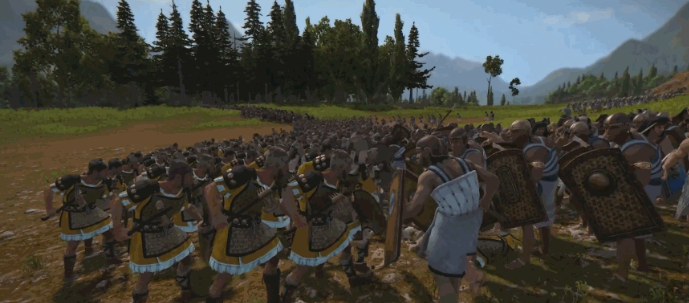
While enabling stances for individual units, you can also achieve the effect of changing defensive lines or adjusting the frontline by having veteran units withdraw while new units advance. This allows players to have greater control over their engaged units, avoiding situations where movement orders are interrupted due to combat, as seen in previous titles. This feature provides a more convenient way for players to maneuver their forces during battles.
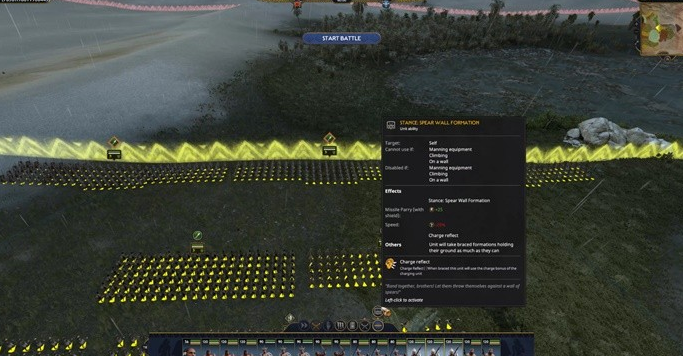
In addition to the introduction of stances, the game has incorporated several new features and details. The "Armor Strength" attribute, which provided damage reduction, has been replaced with a version similar to "Rome 2," where it now functions more like a "shield" that can block a certain number of attacks. Certain special units have the ability to instantly switch between sword and shield and two-handed weapons, allowing for dynamic changes in their functional roles. Battles between soldiers now feature corresponding animations for individual combat interactions, rather than the previous mechanistic and unrealistic clash of weapons in the air.
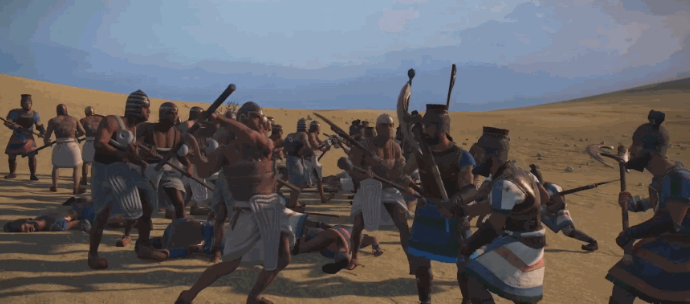
As the core of the entire army, the General's retinue has also received optimizations. Now, the types of soldiers in the General's retinue are tied to the weapons equipped by the general. By changing equipment on the campaign interface, the General's retinue can transform into different unit types such as infantry, archers, or chariots. This not only gives them a greater sense of presence but also avoids the rigid utility of having a single type of General's retinue in previous historical titles.
As the main force of mobile units in the Bronze Age, chariots in "Pharaoh" hold a position of significant combat power. In the second battle against the Hittites, the AI-controlled Hittite chariots effortlessly broke through the shield wall formed by heavily armored spearmen and inflicted considerable damage to my formation. However, despite their terrifying impact, once these chariots come to a halt, their weak melee capabilities make them vulnerable to being quickly overwhelmed by infantry encirclement. When I deployed multiple defensive lines, these chariots quickly faltered due to their "diminishing returns" in effectiveness...
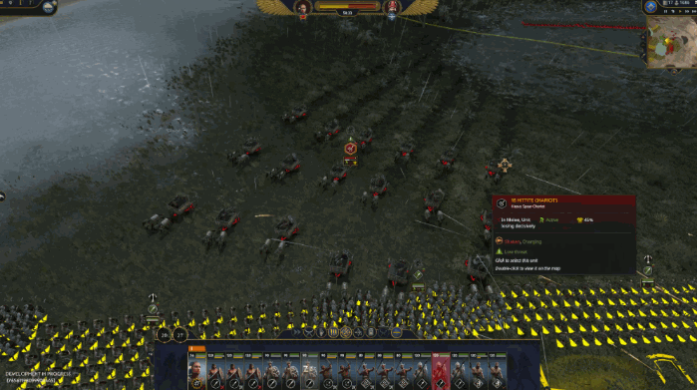
Compared to the "chariots of doom" that could plow through the entire battlefield in the early release of "Troy," the strength of chariots in "Pharaoh" can be considered more balanced. This also applies to my experience in controlling other units. You cannot rely on extremely extreme compositions and strategies like the fully-equipped Roman legions in "Rome 2" or the all-cavalry Hun army in "Attila" to bulldoze everything. The core of the battle section in "Pharaoh" lies in the control and combination of multiple unit types.
Dynamic Weather and Improved Siege Battles
In historical titles, players are often given the option to choose the weather conditions before a battle commences. Depending on the chosen weather, the entire battlefield undergoes different changes, which naturally affect the units within it. This feature accurately reflects the reality of warfare being influenced by the weather. However, in practice, weather conditions that obstruct visibility, such as fog, or extreme heat that intensifies fatigue, are often selectively skipped by players, diminishing the significance of the weather system.
The Sofia studio is well aware of this issue, and in "Pharaoh," they have implemented a dynamic weather system. In simple terms, the weather on the battlefield changes in real-time during all manual battles. One moment it may be sunny, and the next it could be a sandstorm engulfing the area. Besides the visual changes, these weather conditions also have an impact on the battlefield. Rainy weather reduces the attack range of ranged units, while sandstorms not only slowly drain the health of all units but also further decrease their movement speed. In addition to affecting the units, weather changes also alter the terrain. Previously dry flatlands can become muddy and difficult to traverse due to rainfall, while drought conditions can cause fires to spread in trees and vegetation, further influencing the entire battle.
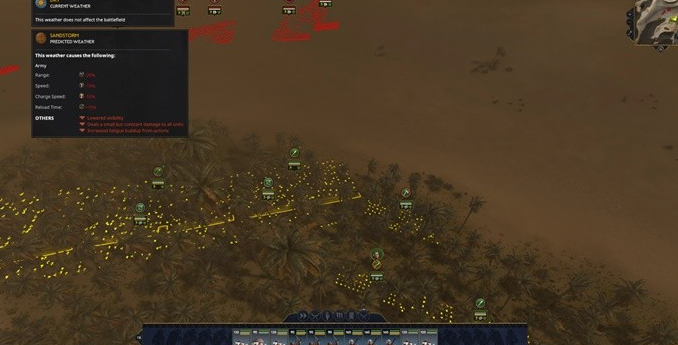
During the trial play, the changing weather indeed had an impact on the overall battle situation. However, because the tactics and gameplay within a single battle are primarily determined by unit composition, the dynamic weather alone cannot fundamentally change the player's approach. If ranged infantry encounters rainy weather, for example, they still have no choice but to rely on archery. Similarly, the sandstorm that slows down movement speed does not render fast-moving units ineffective. In terms of a single battle, while the dynamic weather system increases its presence, it does not change the fact that its impact is limited. However, the battlefield in "Total War" is not limited to individual battles. It is hoped that with the inclusion of the campaign map, this system will become more useful.
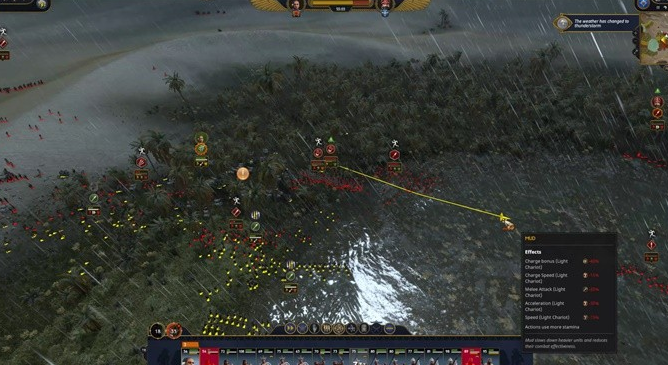
Compared to the somewhat lackluster dynamic weather, the changes in siege battles feel more practical. While retaining the core gameplay of 360° siege battles from previous Total War titles, "Pharaoh" has made some optimizations to the victory point system. The most significant change is the addition of unique map-wide buffs for each victory point. When the defending side occupies a victory point, it provides morale and healing buffs to all defending units, aiding them in battle. On the other hand, for the attacking side, capturing victory points not only cuts off the defender's buff supply but also allows the captured points to have a detrimental effect on the defender by continuously reducing their morale, thus speeding up the progress of the battle.
This modification makes victory points more important and provides a better interactive experience for both attackers and defenders. The defending side cannot simply hold onto the walls, while the attacking side can try new strategies beyond completely annihilating the defending forces. Although this change may seem minor, it enriches the gameplay of siege battles and enhances the overall enjoyment of this battle type. However, the trial play did not include battles for minor towns or settlements, so the final experience of siege battles will have to wait for the official release of the game.
Conclusion
In conclusion, if you are a fan of historical titles in the Total War series, the battle experience in "Pharaoh" can be described as good, even resembling an enhanced version that combines the strengths of various historical titles. However, Total War games have never been solely focused on the battle aspect, and the overall gaming experience relies on the integration of the campaign section as well. Therefore, the ultimate quality of the game can only be revealed after its official release.
